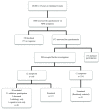Parkinsonian symptoms in normal pressure hydrocephalus: a population-based study
- PMID: 28879446
- PMCID: PMC5617872
- DOI: 10.1007/s00415-017-8598-5
Parkinsonian symptoms in normal pressure hydrocephalus: a population-based study
Abstract
It may be challenging to differentiate normal pressure hydrocephalus (NPH) from neurodegenerative disorders such as Parkinson's disease. In this population-based study, we wanted to describe the frequency of parkinsonian symptoms among individuals with and without NPH, and whether the motor examination part of the Unified Parkinson's Disease Rating Scale (UPDRS-m) score differs between these groups. Furthermore, we wanted to find out whether there was a relationship between UPDRS-m score, NPH symptoms, and radiological signs of NPH. A sample of 168 individuals over the age of 65 with and without self-reported symptoms of NPH underwent a computerized tomography of the brain and clinical examination, including UPDRS-m to grade parkinsonian symptoms. According to diagnostic guidelines, 38 fulfilled criteria for NPH, whereas 130 had unlikely NPH. Bradykinesia was significantly more common among those with NPH (79%) compared to those with unlikely NPH (32%) (p < 0.001). The corresponding figures for rigidity were 43 vs. 15% (p < 0.001), for postural instability 71 vs. 22% (p < 0.001), and for tremor at rest 5 vs. 6% (not significant). The total UPDRS-m score was significantly higher among individuals with NPH (median = 12) than without (median = 1) and correlated significantly with the degree of NPH symptoms (r = -0.72) and ventriculomegaly (r = 0.31). In this study, parkinsonian symptoms, except resting tremor, were frequent in individuals with NPH and correlated with the severity of NPH symptoms. Asymmetric symptoms were uncommon. We recommend a liberal use of neuroradiological imaging when investigating a patient with parkinsonian features.
Keywords: Hydrocephalus; Normal pressure hydrocephalus; Parkinsonism; Parkinson’s disease; UPDRS.
Conflict of interest statement
Ethical standards
The Regional Ethical Review Board in Umeå approved the study (Dnr 2014/180-31); the study has been performed in accordance with the ethical standards laid down in the 1964 Declaration of Helsinki and its later amendments.
Conflicts of interest
On behalf of all authors, the corresponding author states that there is no conflict of interest.
Sources of funding
Employed by the hospital of Östersund, Region Jämtland Härjedalen, Sweden (KM, KL). Employed by the Unit of Research, Education and Development, Region Jämtland Härjedalen, Sweden (LS). Employed by Umeå University, Sweden (KL). Grants from the Unit of Research, Education and Development, Region Jämtland Härjedalen, Sweden (KL). The authors report no other disclosures.
Informed consent
All participants gave written, informed consent.
Figures



References
-
- Blomsterwall E, Bilting M, Stephensen H, Wikkelsö C. Gait abnormality is not the only motor disturbance in normal pressure hydrocephalus. Scand J Rehabil Med. 1995;27:205–209. - PubMed
MeSH terms
LinkOut - more resources
Full Text Sources
Other Literature Sources
Medical

